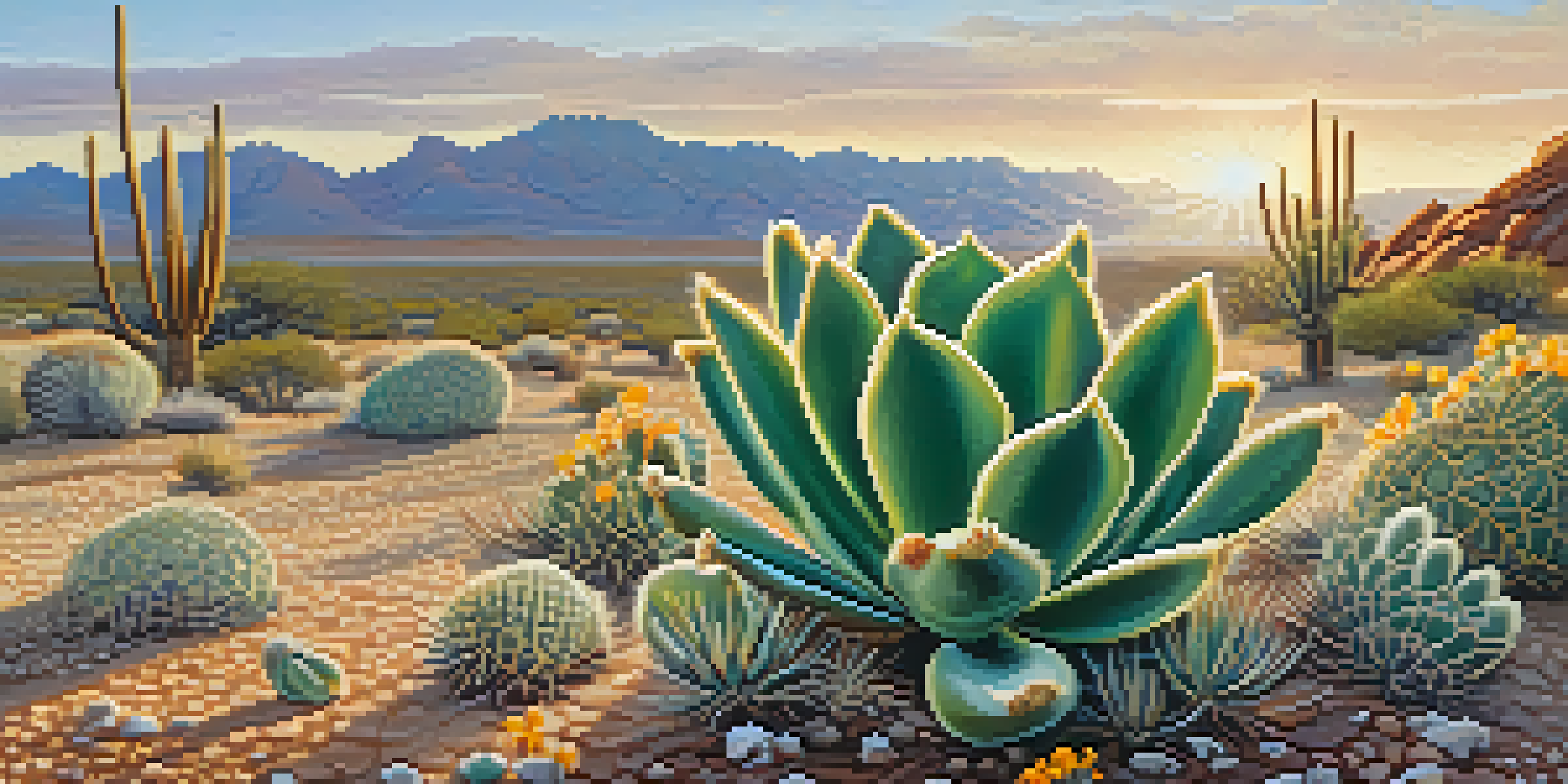The Healing Power of Peyote: Indigenous Perspectives

Understanding Peyote: A Sacred Plant in Indigenous Culture
Peyote, a small cactus native to North America, holds immense cultural significance for many Indigenous tribes. It's not just a plant; it's a sacred tool used in spiritual ceremonies and healing practices. The cactus contains mescaline, a psychoactive compound that induces altered states of consciousness, allowing individuals to connect with their spirituality and the universe.
Peyote is not just a plant; it is a sacred tool for spiritual healing and community bonding.
For generations, tribes like the Huichol and the Navajo have utilized peyote in their rituals, emphasizing its role in promoting mental and emotional well-being. These ceremonies often include songs, prayers, and communal sharing, creating a profound sense of connection among participants. The experience is deeply personal yet shared, reinforcing communal bonds that are vital to Indigenous cultures.
In these contexts, peyote is seen not only as a means to heal the individual but also as a way to restore balance to the community. By engaging with peyote, participants often report insights and revelations that guide them on their life paths, showcasing the plant's powerful role in Indigenous healing traditions.
The Spiritual Journey: Experiences with Peyote
Many who partake in peyote ceremonies describe their experiences as transformative and enlightening. These spiritual journeys often lead to profound self-discovery, as individuals confront personal challenges and gain clarity on their life purpose. The imagery and sensations experienced during the peyote trip are often both vivid and symbolic, leading to deep introspection.

Participants frequently share stories of connecting with ancestors or receiving messages from the spirit world. This connection can foster a sense of belonging and purpose, which is especially important in a world where many feel disconnected from their roots. The shared narratives that emerge from these experiences serve to strengthen community ties, as participants recount their journeys together.
Peyote's Cultural Significance
Peyote is a sacred plant used in Indigenous ceremonies, promoting spiritual healing and community bonding.
Moreover, the emotional release during these ceremonies can lead to significant healing from trauma and grief. By allowing emotions to surface and be processed, individuals often find relief and a renewed sense of hope, making peyote a powerful ally in their healing journey.
Peyote and Mental Health: A Therapeutic Tool
Recent studies have begun to explore the therapeutic potential of peyote in treating mental health issues such as depression and anxiety. The introspective nature of the peyote experience can facilitate therapeutic breakthroughs, helping individuals confront and understand their emotional struggles. This aligns with the concept of 'set and setting,' where the mental state and environment significantly influence the outcome of the experience.
The experience with peyote can lead to profound self-discovery and emotional healing, connecting us to our roots and ancestors.
Unlike conventional therapies, peyote offers a unique approach by engaging the mind in a deeply personal and often spiritual manner. Many individuals report feeling a sense of relief from their mental burdens, as the peyote experience encourages a broader perspective on their problems. This shift in perception can empower individuals to make positive changes in their lives.
However, it's essential to approach this form of therapy with respect and caution. Understanding the cultural significance of peyote is crucial, as is ensuring that these practices are conducted within a supportive and knowledgeable framework to honor Indigenous traditions.
The Role of Elders in Peyote Ceremonies
Elders play a pivotal role in peyote ceremonies, serving as guides and teachers for those seeking healing. Their deep understanding of the plant's significance and the rituals surrounding its use ensures that participants engage with peyote in a respectful and meaningful way. Elders often share their wisdom, stories, and teachings, enriching the overall experience.
In many Indigenous cultures, elders are seen as the keepers of knowledge, having spent years learning from their ancestors and the land. Their presence during ceremonies not only provides a sense of safety but also connects participants to generations of tradition and healing practices. This transmission of knowledge is crucial for the preservation of cultural identity.
Therapeutic Potential of Peyote
Recent studies suggest peyote may help treat mental health issues by facilitating introspective healing experiences.
Furthermore, the involvement of elders fosters a sense of communal responsibility. Participants learn that their healing journey is interwoven with the well-being of their community, promoting a collective approach to health and spirituality that transcends individual experiences.
Cultural Appropriation: Respecting Indigenous Practices
As interest in peyote grows beyond Indigenous communities, the conversation around cultural appropriation becomes increasingly important. It's vital to understand that peyote is not merely a recreational substance; it carries deep spiritual significance for many Indigenous peoples. Engaging with peyote outside of its cultural context can lead to misunderstandings and disrespect.
Respecting Indigenous practices means acknowledging their rights to their traditions and ensuring that any engagement with peyote is done with consent and understanding. This involves educating oneself about the cultural context and the history of peyote use, as well as recognizing the ongoing struggles Indigenous communities face regarding land and resource rights.
By approaching peyote with respect and a willingness to learn, individuals can foster a more profound appreciation for its cultural significance. Supporting Indigenous voices and initiatives is essential to honor the traditions that have existed for centuries and to ensure that these practices continue to thrive.
Legal Challenges Surrounding Peyote Use
Despite its cultural significance, the legal status of peyote poses challenges for Indigenous peoples who rely on it for spiritual practices. In many parts of the world, peyote is classified as a controlled substance, which restricts its use and can lead to legal repercussions for those who partake in traditional ceremonies. This legal framework often fails to recognize the cultural and spiritual importance of peyote.
The Native American Church has fought tirelessly for the right to use peyote in their ceremonies, arguing that it is a matter of religious freedom. Their advocacy has led to some legal protections, but the ongoing debate highlights the tension between Indigenous rights and government regulations. Many Indigenous leaders continue to call for greater recognition of their sovereignty and the importance of peyote within their spiritual practices.
Challenges and Future of Peyote
Legal restrictions and environmental threats pose challenges for the preservation of peyote and its cultural practices.
As discussions around drug policy reform gain momentum, it's crucial to consider the unique cultural context of peyote. Advocating for legal protections for Indigenous practices not only preserves cultural heritage but also promotes a more inclusive understanding of spirituality and healing.
The Future of Peyote: Preservation and Education
As awareness of peyote's healing properties grows, so does the importance of preserving this sacred plant and the traditions surrounding it. Overharvesting and environmental changes pose significant threats to the peyote population, making it essential for Indigenous communities and allies to advocate for sustainable practices. Conservation efforts are vital to ensure that future generations can engage with peyote in a way that honors its significance.
Education plays a crucial role in fostering respect for Indigenous practices and the importance of peyote. By sharing knowledge about its cultural significance, benefits, and the ethical considerations surrounding its use, we can create a more informed public. This understanding can help bridge the gap between Indigenous and non-Indigenous communities, promoting mutual respect and collaboration.

Ultimately, the future of peyote relies on a collective effort to protect its heritage and ensure that its use is approached with the reverence it deserves. By fostering dialogue, supporting Indigenous rights, and advocating for sustainable practices, we can help preserve the healing power of peyote for generations to come.